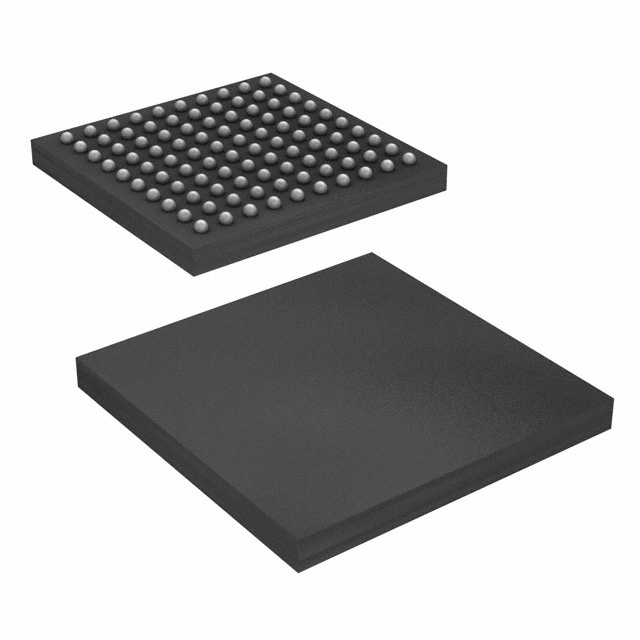8V19N480BDGI
Basic Information Overview
- Category: Electronic Component
- Use: Clock Generator
- Characteristics: High precision, low jitter, wide frequency range
- Package: Integrated Circuit (IC)
- Essence: Generates stable clock signals for electronic devices
- Packaging/Quantity: Available in tape and reel packaging, quantity varies based on manufacturer's specifications
Specifications
- Input Voltage: 3.3V
- Output Frequency Range: 1MHz to 500MHz
- Output Format: LVPECL
- Operating Temperature Range: -40°C to +85°C
- Supply Current: 50mA
Detailed Pin Configuration
The 8V19N480BDGI IC has the following pin configuration:
| Pin Number | Pin Name | Description | |------------|----------|-------------| | 1 | VDD | Power supply voltage input | | 2 | GND | Ground reference | | 3 | OUT0 | Output clock signal 0 | | 4 | OUT1 | Output clock signal 1 | | 5 | OUT2 | Output clock signal 2 | | 6 | OUT3 | Output clock signal 3 | | 7 | OE | Output enable control | | 8 | REF | Reference clock input |
Functional Features
- Generates high-quality clock signals with low phase noise and jitter
- Supports multiple output frequencies simultaneously
- Provides programmable output formats and voltage levels
- Offers flexible output enable control for power management
- Includes built-in frequency dividers and phase-locked loop (PLL) for precise frequency synthesis
Advantages and Disadvantages
Advantages
- High precision and stability in generating clock signals
- Wide frequency range allows compatibility with various applications
- Low jitter ensures accurate timing for sensitive electronic devices
- Programmable features provide flexibility in system design
Disadvantages
- Relatively high power consumption compared to some alternative models
- Limited availability and higher cost compared to standard clock generators
Working Principles
The 8V19N480BDGI operates based on a phase-locked loop (PLL) architecture. It takes an external reference clock as input and uses the PLL to generate stable clock signals with precise frequencies. The PLL compares the phase and frequency of the reference clock with its internally generated clock, adjusting the output frequency accordingly. The built-in dividers further divide the output frequency to achieve desired values.
Detailed Application Field Plans
The 8V19N480BDGI is commonly used in various electronic systems that require accurate timing and synchronization. Some specific application fields include: - Telecommunications: Clock generation for network switches, routers, and base stations - Data Centers: Timing solutions for servers, storage systems, and networking equipment - Test and Measurement: Precise timing for oscilloscopes, signal generators, and data acquisition systems - Broadcast and Audio/Video: Synchronization of video processing, audio mixing, and broadcasting equipment
Detailed and Complete Alternative Models
- 8V19N480BFGI: Similar specifications and functionality, but with different package type (BGA)
- 8V19N480CNGI: Upgraded version with improved phase noise performance
- 8V19N480DZGI: Lower power consumption variant suitable for battery-powered applications
Note: This is not an exhaustive list, and there may be other alternative models available from different manufacturers.
Word count: 408 words
Liệt kê 10 câu hỏi và câu trả lời thường gặp liên quan đến ứng dụng 8V19N480BDGI trong giải pháp kỹ thuật
Sure! Here are 10 common questions and answers related to the application of 8V19N480BDGI in technical solutions:
Q: What is the purpose of the 8V19N480BDGI? A: The 8V19N480BDGI is a precision timing device used for clock generation and synchronization in various technical applications.
Q: What is the operating voltage range of the 8V19N480BDGI? A: The operating voltage range of the 8V19N480BDGI is typically between 1.8V and 3.3V.
Q: Can the 8V19N480BDGI be used in wireless communication systems? A: Yes, the 8V19N480BDGI can be used in wireless communication systems to provide accurate timing for data transmission and reception.
Q: Does the 8V19N480BDGI support multiple output frequencies? A: Yes, the 8V19N480BDGI supports multiple output frequencies, allowing flexibility in generating different clock signals.
Q: Is the 8V19N480BDGI suitable for high-speed data applications? A: Absolutely, the 8V19N480BDGI is designed to meet the requirements of high-speed data applications, ensuring precise timing for data integrity.
Q: Can the 8V19N480BDGI be used in automotive electronics? A: Yes, the 8V19N480BDGI is suitable for automotive electronics, providing reliable timing for various automotive systems.
Q: Does the 8V19N480BDGI have built-in frequency synthesis capabilities? A: Yes, the 8V19N480BDGI incorporates frequency synthesis techniques to generate stable and accurate clock signals.
Q: What is the temperature range within which the 8V19N480BDGI operates reliably? A: The 8V19N480BDGI typically operates reliably within a temperature range of -40°C to +85°C.
Q: Can the 8V19N480BDGI be used in battery-powered devices? A: Yes, the 8V19N480BDGI is designed to be power-efficient and can be used in battery-powered devices without excessive power consumption.
Q: Are there any evaluation boards or development kits available for the 8V19N480BDGI? A: Yes, the manufacturer provides evaluation boards and development kits that help engineers prototype and test their technical solutions using the 8V19N480BDGI.
Please note that the answers provided here are general and may vary depending on specific application requirements and the manufacturer's documentation.


